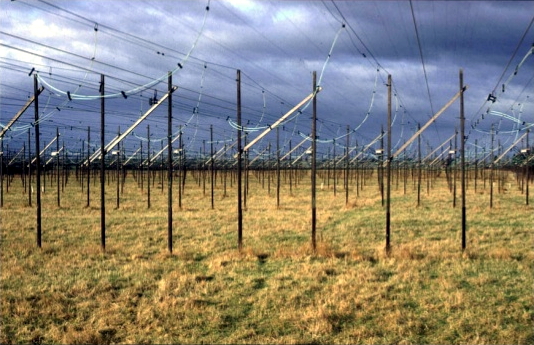Stellar Eavesdropper
On July 15, 1943, British astrophysicist Jocelyn Bell Burnell was born. As a research student, Bell Burnell assisted in the physical construction and operation of a Cambridge university radio telescope, consisting of thousands of poles wired and cabled over several acres of land.

Additionally, once the telescope was operational, she was to monitor and interpret the recordings of the radio transmissions. Since personal computers were still a few years away, she analyzed charts of data manually.
Bell Burnell noticed unusual signals that were regular in their occurrence and clearly distinguishable. She soon recognized that the source of the signal changed its daily position in the sky at the same rate as stars. Her equipment had recorded emissions from the first known pulsar, a unique category of rapidly spinning neutron star that emits regular radio wave bursts that sweep across the earth like the flash of a strobe light. It pulsed repeatedly every 1.3 seconds. When Bell Burnell was able to fix its position, she realized the pulsing radio star was located outside our solar system and in the constellation Vulpecula.
Bell Burnell describes her discovery:
She discovered three additional pulsars within the next few months.
The name pulsar was suggested by a Daily Telegraph journalist from puls[ating radio st]ar. Bell Burnell’s original pulsar, today named PSR B1919+21, was an important milestone in the history of astrophysics because the discovery demonstrated that a space object could be seen and heard. Here was an object with star energy compacted into something about the size of a planet with a magnetic field that could be many millions of times stronger than Earth’s. And just calling for attention!
A Nobel Prize in physics was eventually awarded to her graduate advisor and colleague for the development and use of radio-based telescopes. Bell Burnell’s outstanding contribution of critical fieldwork and insight continues to be recognized by her astrophysicist peers around the globe. She has continued to share her research talents and insights with students and colleagues at University College London, the Royal Observatory, Edinburgh, the Open University, Princeton University, the Royal Astronomical Society, University of Oxford, and the Institute of Physics.
Not only has Bell Burnell received many honours from world associations and societies, she was appointed Commander of the Order of the British Empire (CBE) and fewer than ten years later elevated to Dame Commander of the Order of the British Empire (DBE). In October 2014, Dame Jocelyn Bell Burnell became the Royal Society of Edinburgh’s first female president.
B Bondar / Real World Content Advantage